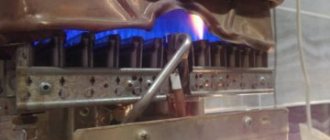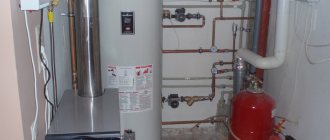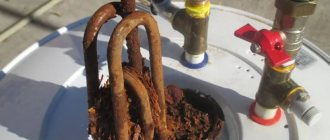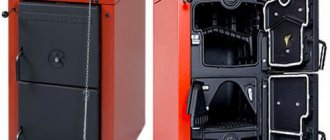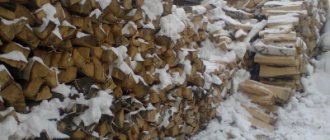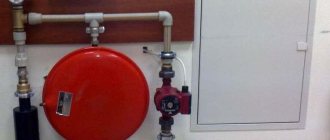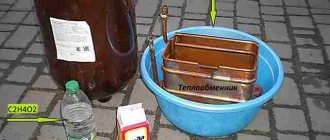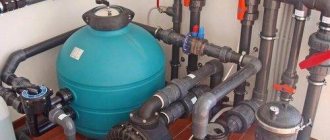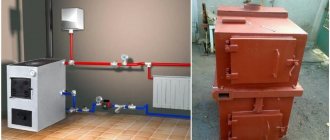Typically, heating boilers are cleaned mechanically or chemically. Gas units are cleaned with partial removal of individual elements and components. Wood and coal are of the non-separable type, so different techniques are used for them. Let's look at the most popular, proven methods using specific examples.
Do-it-yourself boiler cleaning Source wp.com
What is the danger of scale for a gas boiler?
The main problem is that scale can completely clog the coil or gas boiler circuit. The water will stop flowing and expensive repairs will be required.
On the other hand, scale has low thermal conductivity compared to metal, and therefore causes excessive gas consumption. At the same time, the boiler begins to consume 10-30% more fuel.
In addition, scale causes aging of the metal, so there is a risk that the boiler coil may burst and create an emergency situation. And this is fraught with defrosting of the heating system. What is it - read in Yandex.
When to do cleaning
There are 3 options for the development of events:
- Preventative cleaning of a gas boiler is done by the homeowner himself once every 2 years at the lowest cost.
- The procedure is carried out as the heat exchangers become contaminated with soot and scale, which reduces the efficiency of heating and water heating for domestic hot water needs. In this situation, you can still clean the boiler yourself, although calling a specialist is also possible.
- The heat generator stopped due to a breakdown, which often happens during the heating season. The fault is fixed by a called specialist, who also cleans the heat exchanger of soot.
In the photo, a master is servicing a condensing boiler with a closed cylindrical combustion chamber.
There is a heat exchange coil inside, which it is better not to touch yourself. The last 2 scenarios are clearly unattractive for the owners of the house, since they are associated with inconvenience and financial costs. You cannot do without a specialist even if a condensing boiler with a burner and a heat exchanger of a special design is used for heating. It is not recommended to climb there yourself, unless you are well versed in heating equipment of this kind.
Conclusion: preventive cleaning and flushing of the heat exchanger of a double-circuit gas boiler is performed quite quickly and does not require any expense, which is why it is the optimal solution.
Why and at what temperature does scale form in a boiler?
Scale is formed because when water is heated above 60-80C, the hardness salts contained in it (mainly Ca and Mg salts) disintegrate into carbon dioxide and insoluble sediment. This sediment is deposited inside the gas boiler.
In addition, there is another mechanism for scale formation that few people know about - electrostatic adhesion. Read more about this mechanism on our website: About scale and methods of dealing with it.
Cleanable nodes
This type of equipment contains the following components that need to be cleaned periodically:
It is worth noting that cleaning each component of a gas boiler has its own specifics, which we will dwell on in more detail.
Igniter
When the igniter is functioning normally, its flame should look like a cone with a blue tint. If the flame turns yellowish, this means that the burner is dirty.
The cleaning procedure occurs in the following sequence:
Burner with nozzles
This part is the main one in the design of wall-mounted and floor-standing gas boilers, since it is intended directly for supplying fuel.
The sequence for cleaning the burner with nozzles is as follows:
- the gas supply valve closes;
- the burner is removed from its installation location;
- the location of the nozzle is noted, and then it is carefully unscrewed;
- You need to carefully clean the nozzle with a brush;
- the burner is cleaned with a brush, and its hole is purged using available pumping equipment;
- the nozzle is inserted into the burner according to the mark;
- the burner is installed in place.
Expert advice: cleaning the burner with nozzles should be done once a year, preferably before the heating season.
Gas filter
This device is designed to purify incoming gas from various types of contaminants and impurities.
Therefore, it is very important to regularly clean the filter from accumulated clogging.
Heat exchanger
It is worth knowing that the main purpose of the heat exchanger of a double-circuit boiler is how much water will be heated and at what speed.
It is also necessary to understand that this element of the boiler unit can become clogged both inside and outside.
The outer part of the heat exchanger becomes contaminated with soot, which negatively affects its functioning. This boiler unit can be cleaned of soot mechanically, in other words, cleaning is done with your own hands.
To do this you will need the following set of tools:
An important point: try to use a tool for cleaning that does not have sharp edges. Otherwise, you may cause damage to the heat exchanger, which may cause corrosion of the product in the future.
How to remove hardness salts from water?
Hardness salts that are harmful to the boiler can be removed from water through the use of various filters or water treatment units.
To select filters, first of all, you need to do a chemical analysis of the water, which must contain the following data:
- Hardness of water;
- Amount of iron;
- Dry residue;
These are the key factors. Water hardness is scale, iron is rusty stains on plumbing fixtures (sometimes not removed by anything). Dry residue is the amount of suspended particles in water.
To combat water hardness, it is softened - filters are used to soften (desalt) water. Iron is removed by iron filters; suspended particles are retained by mechanical filters.
Water softener filters operate using an ion exchange mechanism.
Pictured: household filters for mechanical cleaning and iron removal in a country house
The composition and capacity of the water treatment plant depends on the initial water quality and the planned volume of consumption. To calculate these indicators, it is better to contact water treatment specialists.
Scale in a gas boiler symptoms
However, it is not always possible to completely remove hardness salts from water. Good water treatment is very expensive, therefore:
Always monitor the following gas boiler performance indicators:
- Sound when the boiler is operating. When dirty, the boiler begins to make dull sounds and crackle when heated.
- Increased gas consumption.
- Increasing the time for heating water to the required temperature.
- A sharp drop in water pressure in taps. The reason for this may be a decrease in the flow area in the boiler.
If these signs are present, immediately descale the boiler!
Remember that if the water flow through the boiler has disappeared, in 99% of cases this is a major repair!
What boiler cleaning product should I use?
There are many tips on the Internet on using household products for flushing a gas boiler. It is recommended to rinse with vinegar, lemon, soda, Coca-Cola, Sprite and other substances. So let's say right away:
Household products will not help flush a gas boiler!
Yes, they will help clean the kettle from fragile scale. However, the scale that forms in boilers is completely different. Under the influence of pressure and high temperature, it acquires high strength and sinteres. Therefore, special products must be used to clean domestic boilers.
Household detergents from the store are also not suitable, since they are designed for manual cleaning of tiles, bathtubs, and sinks from scale and rust.
There are many imported cleaning products, such as Rotenberger, Electrolux, which remove scale well, but are very expensive.
For example, a 30-liter canister of Rotenberger product costs more than 6,000 rubles. And it also requires a neutralizing powder, which costs 2,000!
But flushing a domestic boiler does not require as much reagent. Coils of domestic wall-mounted boilers have a capacity of 0.1 to 2 liters, coils of floor-standing gas boilers - from 10 to 100 liters.
Almost all descaling products are diluted in a ratio of 1 to 10. That is. For 10 liters of water you will need 1 kg or 1 liter of descaling agent.
Those. To flush a wall-mounted gas boiler you need a maximum of 1 kg of product, and to flush a floor-standing gas boiler - a maximum of 10 kg!
Based on our many years of experience in researching various types of deposits, we have developed a reagent for flushing boilers - Kratol K, which perfectly dissolves any boiler scale and is safe for the boiler metal!
Pictured: Kratol K reagent
The cost of the Kratol reagent is 280 rubles/kg. The product is supplied in powder form. You can order the Kratol K reagent and do the descaling of the boiler yourself.
The reagent costs for flushing a wall-mounted boiler will be 280 rubles, and for flushing a floor-standing boiler - no more than 2,800 rubles!
Special cleaning equipment
A booster (installation for washing heat exchangers) is a rather rare and expensive equipment (40-90 thousand rubles), which is simply unprofitable to buy for personal purposes, no matter how often you clean it. It is a container with a built-in circulation pump that supports a change in flow direction - reverse, which increases the efficiency of washing. The devices are resistant to any reagents used.
PIPAL PUMP ELIMINATE 20 V4V
One of the best Italian-made units. It has compact dimensions and optimal performance - 2600 l/hour (44 l/min). Tank volume – 18 l, permissible pressure – 1 bar. Known for its simplicity and reliability.
BWT Cillit SEK 28
An equally well-known, proven German-made installation. Capacity – 2400 l/hour, the operating principle is no different from the previous installation, designed for higher temperatures – up to 60°C. It has even more compact dimensions and a convenient handle for transportation.
How to choose a water softener for a gas boiler and extend the life of the heat exchanger
Which pump should I use to flush a gas boiler?
If you want to assemble a flushing circuit, you will need an expansion tank, pump, and hoses. It is better to take a stainless steel pump so that it can be used repeatedly.
It is forbidden to flush boilers with household circulation pumps to avoid their damage!
What options might there be?
1. Buy a special chemical pump for flushing boilers and heat exchangers (booster). This equipment is a single unit in which a pump with hoses (forward and return lines) is mounted on the expansion tank. Models vary in expansion tank volume and cost. For wall-mounted boilers, the younger model – 10 liters – is quite enough. For floor-standing boilers, it is advisable to take a pump with an expansion tank of 20 liters or more.
The cost of chemical boosters is quite high - from 50,000 rubles.
Pictured: professional chemical pump with 14 liter tank
2. Assemble the flushing circuit yourself. For this you can use: any pump (even a country house Malysh), hoses, a plastic bucket. This pump is enough for several flushes.
3. Rental of a chemical pump. In principle, we can provide you with a chemical pump for rent, teaching you all the rules for flushing. Sometimes this is a more preferable option, since, as you have already seen above, prices for chemical pumps start from 50,000 rubles.
Renting a chemical pump for 15 liters costs 5,000 rubles per day. Why per day? This time is simply enough to flush one boiler. Typically, the flushing cycle lasts 3-4 hours.
Chemical flushing of industrial boilers - Overview.
Authors :
Mo D. Majnouni, Aramco Service Company, and Arif E. Jaffer, Baker Petrolite Corporation
Abstract
In order to ensure efficient heat exchange, the internal surfaces of boilers in direct contact with water and steam must be kept clean and free of deposits.
This article provides guidance on when and how it is appropriate to chemically flush boilers. Several methods can be used to determine the need for chemical boiler flushing.
The fire (frontal) surface of boiler pipes usually consists of magnetic iron ore (magnetite) and copper. The article emphasizes the cost effectiveness of various chemical cleaning agents for boilers contaminated with various types of deposits. Chemical boiler flushing must be carefully planned. The criteria that determine the success of chemical procedures and the effectiveness of reagents for dissolving certain deposits are determined on the basis of detailed analysis.
Dear potential Customer, if you have any questions about how to flush boilers, boilers or steam generators, immediately* call tel. or +7(495) 776-50-79.
There is no secretary on these phones; you will be answered by an experienced employee who will competently advise you on how to flush your boilers and whether they need flushing.
*Provided that you call on a working day before 18-00, or at least before 19-00.
Introduction
The appearance of deposits and scale in boilers is an inevitable, progressive process. Even with good water treatment and strict control of condensate using chemical additives, scale and deposits will appear.
Deposits cause the following main problems:
-Increasing the temperature of the pipe walls;
-Reduced heat transfer, leading to an increase in energy costs and loss of reliability.
The increase in pipe wall temperature occurs as a result of the low thermal conductivity of the deposits compared to the metal.
Reduced heat transfer can cause the design temperature of the pipe walls to be exceeded, which can ultimately lead to pipe failure due to creep failure. Heat transfer efficiency is defined as the ratio of boiler output to fuel consumption, once deposits begin to reduce heat transfer, more fuel will be required to produce the design temperature, i.e. There is a general loss of efficiency and loss of energy. Ultimately, removing deposits and scale from the boiler becomes imperative to prevent damage. One way to remove deposits and scale is to chemically flush the boiler. Chemical boiler flushing is a multi-stage process aimed at removing all existing types of deposits from the internal surface of boilers, as a result of which the hydraulic system should remain clean and decontaminated.
This article reviews the criteria for chemically cleaned industrial hot water boilers with operating pressures up to 900 psi. inch (63.3 kg/sq.cm), which are used to generate steam and are used in factories. The article talks about the main stages of chemical cleaning and the selection of specific chemical reagents that should be used at each specific stage, with special attention paid to the removal of iron and copper scale.
Chemical composition of deposits in boilers.
The main component of deposits in boilers is magnetite (Fe3O4), which is formed as a product of the reaction of metallic iron with high-temperature steam. Other crystalline materials, some of them are listed in Table. 1 may also form deposits. Copper is present due to corrosion of copper alloys in aluminum bronze feedwater condensers and preheaters, often due to oxygen infiltration into these systems. Copper is transported through the steam unit, where its particles settle on the internal surfaces of the boiler. Other components presented in Table. 1, settle on the internal surfaces of the boiler in the same way, and in addition they can occur from contamination of the feed water or the use of outdated water treatment products based on phosphoric acid salts. In addition to crystalline inorganic compounds, organic sediment may be present in sediments.
| Table 1: Composition of boiler deposits | ||
| Components | Formula | |
| Anhydrite | Anhydrite | CaSO4 |
| Aragonite | Aragonite | CaCO3 |
| Brucite | Mg(OH)2 | |
| Copper | Copper | Cu |
| Calcite | Calcite | CaCO3 |
| Hematite (red iron ore) | Hematite | Fe2O3 |
| Hydroxyapatite | Hydroxyapetite | Ca10(OH)2(PO4)6 |
| Magnetite (magnetic iron ore) | Magnetite | Fe3O4 |
| Quartz | Quartz | SiO2 |
| Trinardite | Thenardite | Na2SO4 |
| Volostanitis | Wollastonite | CaSiO3 |
When developing a chemical wash plan, it is necessary to take into account the various components present in the sediment in order to select the optimal chemical reagents.
The reagents recommended based on the analysis should effectively remove deposits and scale without damaging the metal underneath. Determining the need for chemical flushing of the boiler.
The need for chemical flushing is identified during routine inspections of the working parts of the boiler. The inspection should identify the problem areas of the boiler that are most affected by corrosion or contain the largest amount of deposits. Other factors influencing the decision to conduct inspections:
— loss of overall efficiency;
— the presence of areas of overheating - for example, evidenced by infrared studies;
— destruction of pipes during normal operation.
If data obtained during a routine inspection indicates that a chemical inspection may be necessary, collecting boiler tube cuttings is the most reliable method of performing a preparatory analysis. Pipe cuttings should be taken from problem areas. The length of the pipe cut should be at least 3 feet (about 1 meter) to ensure that the sampling tools (cutting wheel or cutting torch) do not contaminate the scale in the center of the cut with scale or filings. Then the deposits must be analyzed; there are several methods for determining their chemical composition.
The density of scale is determined by the gravimetric method after dissolution in inhibited hydrochloric acid. The weight loss when heated in the oven determines the percentage of hydrocarbons, which then determines the need for alkaline degreasing. The need for cleaning is determined based on sediment density analysis. Table 2 shows the sediment density scale according to the required actions.
| Table 2. Sediment Density and Adequate Action Scale | |
| Sediment density g/sq.ft (mg/sq.cm) | Recommended Actions |
| < 23 (25) | There is no need to do anything |
| 23-70 (25-75) | Chem. flushing for one year |
| 70-93 (75-100) | Chem. flushing within 3 months |
| >93 (100) | Chem. flushing before resuming operations |
Steps for Chemical Boiler Flushing and Treatment Selection .
Boiler cleaning usually consists of a combination of the following steps:
— Mechanical cleaning
— Washing with water
— Treatment with alkalis
— Cleaning with organic solvents
— Neutralization and passivation
Mechanical cleaning and water flushing can remove loose scale and other unconsolidated deposits from the interior surface of the boiler. Alkaline treatment removes oils and hydrocarbons that may prevent acidic washes from dissolving deposits. At the organic solvent cleaning stage, deposits are removed from the boiler using inhibited acid-based reagents. Once they are removed, the newly purified active metal becomes unprotected. A neutralization and passivation step is used to remove any remaining traces of iron oxide and coat the active metal with a well-passivated layer.
The composition of deposits, their quantity and distribution vary greatly from boiler to boiler and even within the same boiler at different periods of its operation. Therefore, it is necessary in each case to carry out a specific wash or series of washes in order to most effectively clean the boiler thoroughly and safely, according to the specified standards. This part of the article serves as a guide to choosing types of cleaning.
The main criteria that must be met are:
— Cleaning must be safe and compatible with the materials from which the equipment being washed is made.
— Sediments must demonstrate sufficient solubility during the selected type of cleaning. It is necessary to pay attention to the possibility of the formation of any insoluble substances during the reaction and to prevent their formation, which will allow achieving the specified degree of purification.
Satisfying these criteria, make your final choice, however, it is worth taking into account other criteria such as cost, waste disposal problems and time allocated for washing.
Chemical cleaning typically involves one or more of the following steps:
- hot alkaline degreasing,
- removal of copper,
— washing with acid-based reagents followed by neutralization and passivation
Laboratory studies will determine the sequence of chemical treatment steps.
Hydrodynamic flushing can be used to remove uncemented deposits. If hydrodynamic washing has been carried out, it should be followed by removal of corrosive deposits and passivation. Remote fiberscope surveys, videotaped and sediment density analysis of pipe cuttings, before and after chemical flushing, will provide visual confirmation of the effectiveness of chemical flushing. Hot alkali treatment stage.
If oil, grease, carbon or any organics are present, they must be removed through a chemical cleaning process. The choice of method depends on the degree of contamination. Hot caustic treatment is used only in cases where organic deposits would interfere with the effectiveness of chemical cleaning. If the solubility of the scale in the wash agent is greater than 70% with or without the addition of surfactants, a separate hot caustic treatment step is not required.
Degreasing with soda ash (Na2CO3) is a mild treatment used in cases where the contamination initially consists of light oil or grease; with less than 5% content of organic contaminants. Table 3 shows control parameters for alkaline degreasing with soda ash.
| Table 3. Control parameters for alkaline degreasing with soda ash. | ||
| Chemicals | Concentration | |
| Sodium carbonate | Sodium carbonate | From 0.5 to 1.0% by weight |
| Sodium metasilicate | Sodium metasilicate | From 0.5 to 1.0% by weight |
| Trisodium phosphate | Trisodium phosphate | From 0.5 to 1.0% by weight |
| Surface-active substance | Surfactant | From 0.1 to 0.2% of volume |
| Defoamer (if required) | Antifoam (if required) | From 0.05 to 0.1% of volume |
| Temperature limit | Temperature Limit | 155 °C |
| Circulation | Normal working | |
| Processing time | 18 to 24 hours | |
| Corrosion rate | Corrosion Rates | <2 mpy |
Caustic soda (NaOH) degreasing is commonly used on all new boilers; if secondary scale is present or if contamination is from 5 to 30%. Table 4 shows control parameters for caustic soda degreasing.
| Table 4. control parameters for degreasing with caustic soda. | ||
| Chemicals | Concentration | |
| Sodium hydrate (caustic soda) | Sodium hydroxide | 1.0 to 2.0% by weight |
| Trisodium phosphate | Trisodium phosphate | From 0.5 to 1.0% by weight |
| Surface-active substance | Surfactant | From 0.1 to 0.3% of volume |
| Defoamer (if required) | Antifoam (if required) | From 0.05 to 0.1% of volume |
| Temperature limit | Temperature Limit | 155 °C |
| Circulation | Normal working | |
| Processing time | 18 to 24 hours | |
| Corrosion rate | Corrosion Rates | <2 mpy |
Potassium permanganate (KMnO4) is used where the amount of organic contaminants is significant (>30) and coked. This treatment should only be used where the type and quantity of contaminants cannot be removed otherwise, as the cost, disposal problems and complexity of subsequent chemical washing are significantly higher than alternative options. Control parameters for alkaline degreasing with permanganate are shown in Table 5
| Table 5. Control parameters for alkaline degreasing with permanganate. | ||
| Chemicals | Concentration | |
| Sodium hydrate (caustic soda) | Sodium hydroxide | 1.0 to 2.0% by weight |
| Potassium permanganate | Potassium permanganate | 1.0 to 3.0% by weight |
| Temperature limit | Temperature Limit | 100 °C |
| Circulation | From1200 l/min to 4500 l/min | |
| Processing time | From 6 to 12 hours | |
| Corrosion rate | Corrosion Rates | <2 mpy |
Where sediments contain large amounts of calcium sulfate (i.e. 10%), sulfate conversion treatment may be necessary and economically feasible. It will help increase scale solubility during subsequent treatment with acidic washes such as inhibited hydrochloric acid. Control parameters for sulfate conversion treatment are shown in Table 6.
| Table 6. Sulfate Conversion Processing Control Parameters | ||
| Chemicals | Concentration | |
| Sodium carbonate | Sodium carbonate | From 1.0 to 5.0% by weight |
| Surface-active substance | Surfactant | From 0.1 to 0.2% of volume |
| Temperature limit | Temperature Limit | 95°C |
| Circulation | From1200 l/min to 4500 l/min | |
| Processing time | 12 to 24 hours | |
| Corrosion rate | Corrosion Rates | <2 mpy |
If the copper concentration in the deposits is greater than 10%, separate treatment is necessary to dissolve as much copper as possible before cleaning with acid washes. Estimate the copper that needs to be removed based on sediment analysis and use one of the following alkali treatments to reduce copper levels to less than 10%. Other alkaline treatments with ammonium carbonate and sodium nitrate are also suitable for removing copper at concentrations greater than 10%. The remaining copper in the boiler will be removed during the acid washing process. Table 7 shows control parameters for copper removal with ammonium bicarbonate, air or oxygen.
| Table 7. Control parameters for copper removal with ammonium bicarbonate, air or oxygen. | ||
| Chemicals | Concentration | |
| Ammonium bicarbonate | Ammonium bicarbonate | 1.6 l/kg copper removed |
| Ammonia-water solution (ammonia) | Aqua ammonia | 2.4 l/kg copper removed pH = 9.5 |
| Air or oxygen | From 1.3 to 1.5 cubic meters per minute | |
| Temperature | 50-60°C | |
| Time of processing | From 2 to 4 hours | |
| Corrosion rate | <2 mpy | |
Stage of chemical cleaning with acid reagents.
Hydrochloric acid –
Since inhibited hydrochloric acid is produced with good dissolving ability towards a wide variety of scales, inhibited hydrochloric acid is the most widely used scale dissolving reagent. This is an economical and easy-to-manage type of chemical wash. When the parameters are followed and when inhibitors are added correctly, this method shows good corrosion performance. The process is quite flexible and can be tailored to remove copper compounds by adding thiourea (H2NCSNH2), to enhance silica removal by adding ammonium bifluoride, or to enhance organic removal by adding a surfactant. This type of washing is not compatible with stainless steel. When the concentration of copper in deposits is more than 10%, separate removal of copper is necessary before using hydrochloric acid. Table 8. Shows control parameters for hydrochloric acid washing.
| Table 8. Control parameters when washing with hydrochloric acid. | ||
| Chemicals | Concentration | |
| Hydrochloric acid | Hydrochloric acid | 3.5 -7.5% by weight |
| Inhibitor | Inhibitor | 0.2 - 0.3% by weight or as recommended by the manufacturer |
| Surfactant | Surfactant | 0.0 to 0.2% by volume |
| Ammonium hydrodifluoride | Ammonium bifluoride | 0.0 to 1.0% of weight |
| Thiourea (H2NCSNH2) | Thiourea | 0.0 to 1.5% of weight (up to 5 kg/kg copper removed) |
| Oxalic acid | Oxalic acid | 1.0% by weight |
| Temperature | 70°C to 82°C | |
| Circulation speed | 1200 l/min to 4500 l/min | |
| Time of processing | From 8 to 18 hours | |
| Corrosion rate | Corrosion Rates | <600mpy |
| Total dissolved iron | Total dissolved Iron | 10,000 mg/l maximum |
Citric Acid -
Citric acid is compatible with alloy steel and requires low levels of chloride solvents and is easy to use, safer and has better anti-corrosion properties than hydrochloric acid. It is less aggressive in dissolving iron oxide deposits and also requires higher temperatures and longer contact times. It has a very limited effect on calcium salts in sediments. And it is usually a more expensive procedure compared to hydrochloric acid cleaning.
Common reasons for choosing citric acid cleaning:
— Availability of austenitic materials of construction.
— The need for the most efficient removal of copper from heavily copper-contaminated deposits
Reduces the overall time of cleaning procedures because there is no need to drain the water, rinse with water and refill the boiler, since the removal of iron, copper, neutralization and passivation can be done with one solution.
Control parameters for citric acid washing are given in Table 9.
| Table 9. Control parameters for cleaning with citric acid. | |
| Chemicals | Concentration |
| Iron removal phase | |
| Lemon acid | 2.5-5.0% by weight |
| Inhibitor | 0.2 – 0.3% by volume or recommended by the manufacturer |
| Ammonium | Add enough to pH 3.5 to 4.0 |
| Copper removal and passivation phase | |
| Ammonium | Add enough to pH 9.2 |
| Ammonium bicarbonate | 1.0% by weight |
| Sodium nitrite | 0.5% by weight |
| Temperature limit: — Iron removal phase — Copper removal and passivation phase | 79°C - 93°C 45°C - 50°C |
| Circulation | 1200 l/min to 4500 l/min |
| lead time | |
| Iron removal phase | 4-8 hours |
| Copper removal phase | 4-8 hours |
| Total dissolved iron | 10,000 mg/l maximum |
| Circulation speed | 1200 l/min to 4500 l/min |
| Corrosion rate | <660mpy |
EDTA –
Cleaning with
ethylenediaminetetraacetic acid
is typically more expensive than citric or hydrochloric acid. In addition, higher temperatures are required to obtain a sufficient degree of purification. Corrosion rates are low, below properly controlled conditions; removal of iron oxides; Copper removal, neutralization and passivation can be achieved sequentially in one solution. EDTA circulates during normal boiler operation and air purge. The need to provide temporary circulation pumps, connection work and tapping into pipes is thus eliminated.
Table 10 shows the control parameters for EDTA purification.
| Table 10. Control parameters for EDTA purification. | |
| Chemicals | Concentration |
| Iron removal phase | |
| EDTA | 3-10.0% by weight |
| Inhibitor | 0.2 – 0.3% by volume or recommended by the manufacturer |
| Ammonium | Add enough to pH 9.2 |
| Copper removal and passivation phase | |
| Sodium nitrite | 0.5% by weight |
| Temperature limit: — Iron removal phase — Copper removal and passivation phase | 121°C - 149°C 60°C - 71°C |
| Circulation | Normal circulation |
| lead time | 12-18 hours |
| Corrosion rate | <200mpy |
Sulfuric Acid –
Sulfuric acid is a very effective solvent for iron oxides, iron sulfides and is usually less expensive than hydrochloric acid. It can be used to clean stainless steel. However, it is much more dangerous to use. Sulfuric acid in this concentrated form is very aggressive and contact with skin or eyes is very dangerous. Sulfuric acid flushing is not recommended if deposits contain large amounts of calcium due to the formation of insoluble calcium sulfates. Table 11 shows control parameters for sulfuric acid treatment.
| Table 11. Control parameters for treatment with sulfuric acid. | |
| Chemicals | Concentration |
| Sulfuric acid | 4.0 – 8.0% by weight |
| Inhibitor | 0.2 – 0.3% by volume or as recommended by the manufacturer |
| Surfactant | 0.0 – 0.2% of volume |
| Temperature limit | 60°C - 82°C |
| Circulation speed | 1200 l/min to 4500 l/min |
| lead time | From 4 to 12 hours |
| Corrosion rate | <600mpy |
| Total dissolved iron | 10,000 mg/l maximum |
Sulfamic Acid –
Sulfamic acid has the advantage that, being a crystalline solid, it is easy to store, apply and mix. It is often sold with an inhibitor and a color indicator to determine the strength of the sulfuric acid solution. This acid is compatible with stainless steel and is a moderately aggressive solvent for iron oxides and calcium carbonates. Due to its relatively high cost, it is usually used for flushing small-volume equipment. Control parameters for sulfamic acid are given in Table 12.
| Table 12. Control parameters for sulfamic acid. | |
| Chemicals | Concentration |
| Sulfamic acid | 5.0 – 10.0% by weight |
| Inhibitor | 0.1 – 0.2% by volume or as recommended by the manufacturer |
| Surfactant | 0.0 – 0.2% of volume |
| Temperature limit | 55°C - 65°C |
| Circulation speed | 1200 l/min to 4500 l/min |
| lead time | From 4 to 12 hours |
| Corrosion rate | <600mpy |
| Total dissolved iron | 10,000 mg/l maximum |
Hydrodynamic cleaning (HDC)
Very effective cleaning for removing uncemented deposits. The use of HDO is recommended after chemical washing with acid-based reagents and neutralization. After using GDO, it is necessary to remove rust deposits and passivate the boiler before starting it up. Table 13 shows the control parameters of GDO.
| Table 13. GDO control parameters. | |
| Equipment | Specification |
| Pump characteristics | 750 kW, 68.94 MPa (10,000 psi) 1500 kW, 137.88 MPa (20,000 psi) |
| Water volume | From 30 l/min to 50 l/min |
| Hole diameter | 0.8 to 2.4 mm |
| Maximum distance between the nozzle tip and the boiler surface to be cleaned | 25 mm |
| Flexible hose diameter | 19 mm minimum |
| Rinse water | Cold steam condensate |
| Supplements | Concentration |
| Polymer | 0.3 of volume |
| Surfactant | 0.1-0.2 of volume |
Neutralization and passivation.
After flushing the boiler with acid-based reagents, it is necessary to carry out neutralization. To perform neutralization only, 0.5% sodium carbonate is usually used; if the pH is 7 or more, then passivation is required, neutralization is achieved during its implementation. The choice of passivation process is influenced by the choice of acid reagent used for chemical washing. After the use of citric acid or EDTA reagents, a long-term neutralization and passivation effect usually occurs with acceptably adjusted pH and the addition of an oxidizing agent. The use of reagents based on citric acid, ammonium and nitrites or reagents with carbon dioxide salt and nitrites must end with neutralization and passivation. As long as the temperature does not rise above ambient temperature, a nitrite phosphate treatment will provide some protection to metal surfaces. If the surfaces have been rusted, the rust is first removed with citric acid, ammonia and sodium nitrite are added later in order to achieve a higher degree of passivation.
The corresponding control parameters are presented in Tables 14, 15, 16.
| Table 14. Control parameters for neutralization with carbon dioxide salt. | |
| Chemicals | Concentration |
| Sodium carbonate | 0.5-1.5% by weight |
| Sodium nitrite | 0.5% by weight |
| Temperature limit | 88°C to 93°C |
| Circulation speed | 1200 l/min to 4500 l/min |
| Time of processing | From 8 to 12 hours |
| Corrosion rate | <2 mpy |
| Table 15. Control parameters for neutralization with phosphates and nitrites. | |
| Chemicals | Concentration |
| Sodium nitrite | 0.5 by weight |
| Monosodium phosphate | 0.25% by weight |
| Disodium phosphate | 0.25% by weight |
| Sodium hydroxide | Bring pH to 7 |
| Temperature limit | 50°C to 65°C |
| Circulation speed | 1200 l/min to 4500 l/min |
| Time of processing | From 8 to 12 hours |
| Corrosion rate | <2 mpy |
| Table 16. Control parameters for neutralization with citric acid, ammonia and sodium nitrate. | |
| Chemicals | Concentration |
| Lemon acid | 2.5 by weight |
| Ammonia | Reduce to 4 during rust removal process and bring pH to 9.5 during passivation process |
| Sodium nitrite | 0.5% by weight |
| Inhibitor | 0.2 – 0.3% by volume or according to manufacturer’s recommendations |
| Temperature limit | Rust removal from 65°C to 90°C |
| Passivation stage | from 45°C to 50°C |
| Circulation speed | 1200 l/min to 4500 l/min |
| Time of processing | From 8 to 18 hours |
| Corrosion rate | <600 mpy in rust removal process and lead <2 mpy in passivation process |
Evaluation of chemical cleaning.
Inspecting the boiler after chemical flushing is a key point in determining the success of the procedure. The effectiveness of flushing is determined visually or using a borescope (a device for inspecting the surface of deep holes). There should be no visible traces of water or loose or coked deposits inside boiler drums and pipes. Remove corrosion test pieces and polarization samples, visually inspect them, determine their weight loss, and calculate the metal thickness loss (typically <25 microns) due to chemical rinsing.
Density of deposits after cleaning:
-cut out the pipe after flushing and determine the density of deposits. Use Table 17 to evaluate the effectiveness of chemical flushing.
| Table 17. Evaluation of the effectiveness of chemical washing. | |
| Presence of sediments, g/ft; (mg/sq.cm) | Performance evaluation |
| 0.93 (1.0) or lower | The best |
| Between 0.93 – 1.86; (12) | The best |
| Between 1.86 – 2.79; (2 – 3) | good |
| Between 2.79 – 4.65; (3 – 5) | Acceptable |
| > 4.65; (5) | Unacceptable |
| Passivation stage | Removing rust at 65°C to 90°C |
conclusions
For efficient operation of equipment, control of corrosion, reliability and prevention of accidents, it is necessary to flush boilers periodically. Purification is achieved by performing a combination of several stages. In some cases, it is necessary to use all stages of flushing; the degree of contamination of the boiler can vary greatly from one to another. The exact procedures that should be used depend on the density of the sediment and the result of its analysis, swelling or broken pipes, water treatment analysis, inspection and history of the equipment being cleaned.
The recommendations formulated in the article do not replace the recommendations of boiler manufacturers regarding their cleaning, especially if the warranty period is valid.
About the Authors
Moe D. Majnauni is a water treatment engineer at Aramco Service Company in Houston. Arif E Jaffer is a senior consultant at Baker Petrolite Corporation in Texas.
Translation of an article published in The ANALIST-the voice of the water treatment industry;
Autumn 2004, Number 4.
Other articles
Flushing heat exchangers
Boiler cleaning cost
Cleaning heat exchangers
Procedure for flushing a gas boiler
So, you have decided what to wash with, what equipment to use, so we proceed with the following sequence of actions.
1. Silence the object being washed. In Russian - turn off the taps supplying water to the boiler and at the outlet of the boiler. Ideally (and this must be taken into account at the design stage!), so as not to have to worry about connecting later, you need to provide two ball valves at the inlet and outlet of the boiler, to which you can easily connect a chemical pump.
Here is an example of the implementation of this approach:
Pictured: taps for flushing a gas boiler
To flush the boiler, the lower two taps (direct and return) are closed, and the pump is connected to the upper two taps. All! Connection takes 5 minutes. And there is no need to drain water, for example from a boiler, which is already hot and ready for use...
So, if you have taps for flushing, connect a pump to them; if taps are not provided, look. As a rule, on wall-mounted boilers you need to disconnect the supply and return. Be careful, sometimes installers do everything so close that you can damage pipes and connections, especially if they are plastic. I hope you remembered to turn off the water supply before disconnecting the pipe!
On floor-standing boilers, at the bottom at the back of the boiler, as a rule, there is a drain (drainage) where you can connect the return (implemented on the Viessman Vitogas 050 boiler):
and a safety valve, with a pressure gauge at the top, where the supply hose is connected:
Be careful, the system operates under pressure, so first of all, stop the pumps, shut off the forward and return lines, release the pressure, and only then start connecting.
We check the tightness - fill the expansion tank of the pump with water and turn on the pump, no chemicals yet. Let's see how it works, whether there are any leaks at the connection points.
Peculiarities
Flushing the heating system cannot be done “blindly”, because you need to know what you will encounter. Typically, batteries do not heat up well when the fluid circulation in them is weak due to debris clogging the internal walls. It is found in the water itself in the form of suspensions of alkali salts, heavy metals and rust. Utilities are required to flush the system annually to prevent a decrease in water flow. But often this task has to be performed by the residents themselves, inviting specialists to clean the radiators from the dirt compacted inside.
This problem is especially typical for cast iron batteries, where sometimes there is a channel for water circulation no more than 1 cm in diameter due to infrequent washing. The cause of clogging of steel radiators is stagnation of rust, due to which they are subject to not only clogging, but also destruction. Not every type of flushing is suitable for such batteries, since after some methods leaks may appear in them. Plastic radiators also become clogged, but cleaning them differs from cleaning their metal counterparts.
This process cannot be called universal, because it is selected specifically for each case. An example of a bad choice is the flushing of the heating system by housing and communal services workers, when they apply powerful pressure by abruptly opening the riser valve located in the basement of an apartment building. This leads to knockout of locking elements and leaks at the junctions of spans. But not every family owner can disassemble the battery into separate bends for the purpose of mechanical cleaning in order to solve the problem of a clogged heating system.
When flushing radiators in an apartment on the lower floors, one cannot always expect the efficiency of the coolant, since for high-quality cleaning it is necessary that the neighbors of all floors of the same branch do the flushing. Otherwise, after cleaning one apartment and washing the batteries by utility workers with high pressure, some of the garbage may fall behind the walls, and mud masses will fall into the newly cleaned batteries. However, it is unlikely that all neighbors will agree when it comes to flushing, but the insufficient internal cross-section creates high hydraulic resistance.
Every mm in thickness of deposits increases fuel consumption by 20-25%. In central heating systems, the water must be pre-treated to reduce clogging. But this is not always done, although residents pay decent amounts every month for house maintenance. In addition, radiators last for decades without replacement. According to the established regulations, flushing of centralized and autonomous systems must be carried out annually. This period is critical. If the pipes are not flushed before the start of the heating season, the pipeline becomes clogged, causing the heating equipment to break down.
If you ignore the blockage, the consequences can be disastrous:
- the heating system may freeze;
- you will have to buy new batteries;
- You will need an electric heater, which will increase the price of electricity.
Preparing a solution for flushing a gas boiler
The detergent (powder or liquid concentrate) is poured into the expansion tank gradually, in accordance with the recommendations for preparing the solution.
If we talk about Kratol K, we recommend using an 8-10% solution at a temperature of about 60°C. Those. for 9 liters of water you pour 1 kg of Kratol K. Attention! The reaction releases carbon dioxide, which squeezes water out of the boiler. To avoid this, place the tap on the return line and close it slightly in case of a strong reaction.
You can judge the effectiveness of the reaction by the gas that will be released into the intermediate tank, foam will form, and the washing solution will darken and become cloudy.
Keep an eye on these indicators. In principle, you can increase the temperature to 60°C (but no more, otherwise acid hydrolysis will begin and the effectiveness of chemical washing will decrease) and increase the concentration of the solution to 10%. Don't worry, nothing will happen to the boiler, especially if you use our detergent. Monitor external parameters. Dilute the acid gradually. Heat gently. In our practice, it also happened that we overheated the boiler, and then boiling acid gushed out in all directions. Not particularly dangerous, but unpleasant.
Consequences of a clogged heat exchanger
The heat exchanger of a gas boiler is a curved pipe made of metal or cast iron. It is heated by the flame of a gas burner, and then transfers heat to the coolant liquid, which moves throughout the heating system. If the heat exchanger is clean, it transfers heat efficiently. When salt deposits accumulate in it, its thermal conductivity decreases. Then the gas boiler has to heat the coolant longer, which entails an increase in fuel and electricity consumption.
If the element is heavily contaminated, in order to maintain the required temperature, it needs to remain in the maximum heated state for a long time - this leads to overheating of the heat exchanger and its failure.
Deposits and scale also prevent the coolant from moving along the circuit. As a result, the load on the circulation pump increases.
Thus, a contaminated heat exchanger threatens failure not only of the element itself, but also of other important components of the unit. To prevent damage, the boiler should be cleaned regularly.
…
Note! In double-circuit models, the secondary heat exchanger, which heats hot water, often fails.
How long does it take to flush a gas boiler?
As a rule, the time for flushing gas boilers is 4-6 hours, depending on the degree of contamination.
You can judge the effectiveness of flushing by the following signs: the appearance of foam, cloudiness of the solution, an increased pungent odor, an increase in the amount of solution in the expansion tank. These signs indicate the presence of a reaction, which means the dissolution of scale.
When washing, you should maintain a temperature of about 50-60°C and monitor the acidity of the washing solution.
Yes, by the way, about measuring pH. It is advisable to buy indicator strips for measuring acidity with indicators from 1 to 14 units (the most acidic and most alkaline environment). During the reaction, the acidity of the solution gradually decreases, the color of the indicators shifts from dark red to yellow (towards a neutral solution).
Neutralization of the washing solution
When you have finished flushing your gas boiler, you will need to neutralize the flushing solution. To do this, stock up on regular soda. And then there are two options:
Or you pour all the flushing solution into a separate container, call the Ministry of Emergency Situations, and they take the solution to a solid waste landfill (just kidding). Or you start adding a little soda to the intermediate tank. The pump is still running. The soda will react with the acid, fizz, and neutralize the latter. At the same time, you measure the pH, and as soon as it reaches 6-7 units (neutral), this solution can be poured into the sewer. It is advisable, in this case, to add cold water to the intermediate tank and drain the solution with a temperature of less than 50°C. These are the regulatory requirements of one of the RD (guidance document) dedicated to chemical washing.
